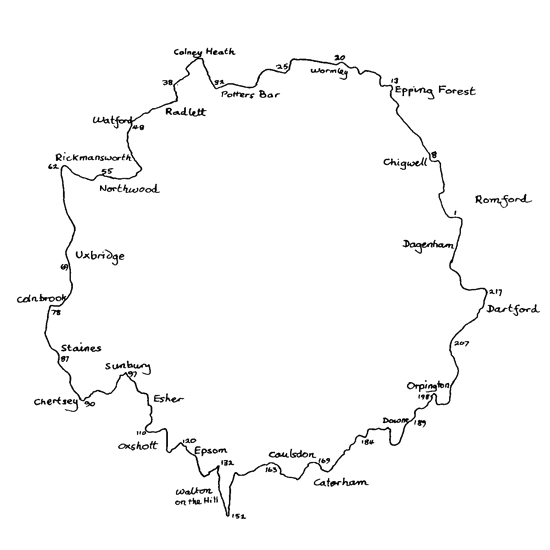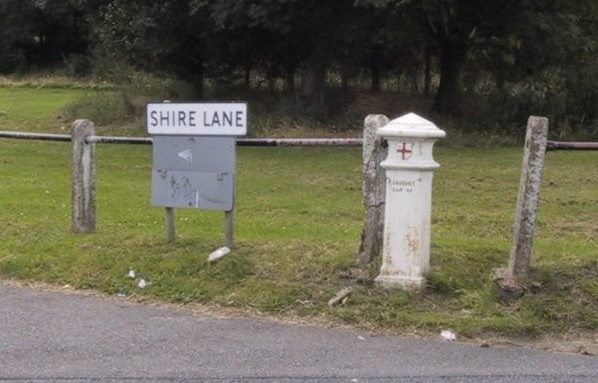


COALTAX POSTS
Coal imported into the City of London had been taxed since medieval times and, as it was originally all brought by sea to riverside wharfs, the collection of duties was relatively easy. The city is a small (one square mile) but influential and rich part of London. The Port of London, within which the duties were payable, stretched far beyond the boundaries of the City, all the way along the Thames from Yantlet Creek (downstream from Gravesend) to Staines.
By the 19th century, however, there was increasing trade by canal and rail, and various Acts of Parliament extended the catchment area to include these new modes of transport. In 1845 the boundary was set at a radius of 20 miles from the General Post Office, London, from Langley in the west to Gravesend in the east and from Ware in the north to Redhill in the south. In 1851 an Act permitted the erection of boundary markers to indicate where this boundary lay; and about fifty markers, inscribed with a reference to the Act, were erected.
In 1861 a further Act – the London Coal and Wine Duties Continuance Act – was passed, reducing the area to that of the Metropolitan Police District plus the City of London. This stretched from Colnbrook in the west to Crayford Ness, at the mouth of the River Darent, in the east, and from Wormley, Hertfordshire in the north to Banstead Heath, Surrey in the south. The map in the panel to the right shows the locations of these posts.
There are nine coaltax posts in the Borough of Bromley, of which five are in the Farnborough area, all at Green Street Green. The Turnpike route changed in the 1830s, and both Old Hill and the main road through Green Street Green would have been considered part of the turnpike. These five are detailed below. For a full list see https://orp.org.uk/coalposts/
See also this page at https://www.bromley.gov.uk
By way of commemoration there is a modern road named Coal Post Close just off the High Street, see photo at the foot of this page.
For more information about the origin and purpose of Coaltax posts see the foot of this page.
Follow these links to go to the entry for each post on the Historic England website.
COAL TAXPOST 191 AT JUNCTION WITH CUDHAM LANE
List Entry Number: 1186817 Heritage Category: Listing Grade: II Location: COAL TAXPOST AT JUNCTION WITH CUDHAM LANE, OLD HILL, ORPINGTON, Bromley, Greater London Authority
COAL TAXPOST 192 OUTSIDE THE CENTRAL SERVICE STATION
List Entry Number: 1261609 Heritage Category: Listing Grade: II Location: COAL TAXPOST OUTSIDE THE CENTRAL SERVICE STATION, FARNBOROUGH WAY, ORPINGTON, Bromley, Greater London Authority
COAL TAXPOST 193 OUTSIDE BAPTIST CHURCH
List Entry Number: 1299018 Heritage Category: Listing Grade: II Location: COAL TAXPOST OUTSIDE BAPTIST CHURCH, HIGH STREET, GREEN STREET GREEN, ORPINGTON, Bromley, Greater London Authority
COAL TAXPOST 194 AT JUNCTION WITH FARNBOROUGH HILL
List Entry Number: 1261585 Heritage Category: Listing Grade: II Location: COAL TAXPOST AT JUNCTION WITH FARNBOROUGH HILL, SEVENOAKS ROAD, ORPINGTON, Bromley, Greater London Authority
COAL TAXPOST 195 AT JUNCTION WITH WARREN ROAD
List Entry Number: 1186818 Heritage Category: Listing Grade: II Location: COAL TAXPOST AT JUNCTION WITH WARREN ROAD, SEVENOAKS ROAD, ORPINGTON, Bromley, Greater London Authority
The last of these has a slightly misleading description as the post is actually at the start of Shire Lane, the other side of Sevenoaks Road from Warren Road.
The Coal tax was abolished in 1889.
Nick Reynolds
TURNPIKE
About Coaltax Posts
About 280 marker posts were
erected to show the boundary within which the coaltax duty was payable.
These cite the Act by regnal year and chapter number, i.e. 24 & 25 VICT CAP 42. In some cases, notably on railways and canals, markers made for earlier acts were reused on the new boundary. Most (over 200) of these posts survive.

Although the title of the Act refers to wine duties, these were collected only in the Port of London: the boundary marks have no connection with the wine duties and it is incorrect to call them "coal and wine duty posts".
Map showing selected Coaltax posts round London, Click to enlarge
The purpose of the posts was to give notice of where the boundary ran so that no-one could claim ignorance of liability to pay the duties. However in general, duties were not actually collected on the boundary. The one known exception was the Grand Junction Canal: originally customs officers collected the duties at Grove Park, Hertfordshire. After the boundary was changed in 1861 a permanent house for the collector was built at Stockers Lock near Rickmansworth. See Photo
In other cases the railway and canal companies or local coal merchants calculated the sums due and paid the money to the Corporation. The railway companies were initially allowed some coal free of duty for their engines.
These cite the Act by regnal year and chapter number, i.e. 24 & 25 VICT CAP 42. In some cases, notably on railways and canals, markers made for earlier acts were reused on the new boundary. Most (over 200) of these posts survive.

Although the title of the Act refers to wine duties, these were collected only in the Port of London: the boundary marks have no connection with the wine duties and it is incorrect to call them "coal and wine duty posts".
Map showing selected Coaltax posts round London, Click to enlarge
The purpose of the posts was to give notice of where the boundary ran so that no-one could claim ignorance of liability to pay the duties. However in general, duties were not actually collected on the boundary. The one known exception was the Grand Junction Canal: originally customs officers collected the duties at Grove Park, Hertfordshire. After the boundary was changed in 1861 a permanent house for the collector was built at Stockers Lock near Rickmansworth. See Photo
In other cases the railway and canal companies or local coal merchants calculated the sums due and paid the money to the Corporation. The railway companies were initially allowed some coal free of duty for their engines.
